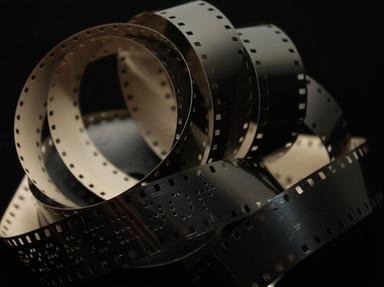Quiz Answer Key and Fun Facts
1. As movie film is rather expensive to work with and our budget is minuscule, we need to know exactly what type of film we need for the given shot. Looking at the script, our shoot is to be filmed primarily in low, indoor light. Knowing this, what two details should we look at first in our film stock?
2. Okay, we've ordered our film. That's one big mark on our checklist of things to do before we start shooting our film. Next, we need to make sure we have at least two of these contraptions on every scene, in the case one breaks down. Without it, we run the risk of over or underexposing our expensive new film. What is it that is so darn important to making sure our film looks good?
3. In our film, we want to record dialogue between the two actors, but our film does not record audio; it will have to be recorded separately and synced in post-production. This seems an easy enough fix, but how are we going to make sure we have the right take and the right audio perfectly, down to the 1/24th of a second we need, in sync?
4. Knowing we are shooting sound with our film, there is one other audio factor we must look at. Film running through a camera is very loud. While to some it is a pleasing sound, in the context of a film it is completely unacceptable. How do we quiet the camera's motors while running the film?
5. Now comes the task of renting our camera from one of the rental facilities in the area. Calling around, we want to double check that we get a crystal-sync camera. A crystal-sync motor runs the film through the camera at exactly 24 fps, all the time.
6. We're almost ready to shoot. We only have a few more items on our checklist to go over before we can make our way to Sundance with our finished masterpiece. While our heads are in the clouds towards our future success, which of the following can we NOT afford to forget?
7. All of our planning has paid off and we had a successful shoot. The actor's performances were mesmerizing, the dolly moved just smooth enough to cut butter and the gentle, muffled sound of the film gate left us all with smiles. What is our next step?
8. We want to edit our masterpiece on our fancy computer. Like Franz Listz, we want to "tickle the ivories" and create beautiful music in the edit room, but if film is "analogue" and a computer is "digital," how can we expect to accomplish this conversion and edit on a computer based, non-linear editing system?
9. After telling the actors their motivations and shooting all of our footage, we do a sneaky move and change the whole meaning of the film. Rather than an award winning coming-of-age film, we make it into a "B-movie" scary film. We accomplish this with discretely shot "b-roll" and CGI artists to create our monster on screen. What is the best method to prepare the film we have already shot for the artists?
10. All of our hard work is done. We've shot our film, added all sorts of effects and are ready to create our master to print to send to the distributor. The only problem we have is our editing time base is 29.97 on the computer and the master print will need to be at exactly 24 fps. What is our next step?
Source: Author
eggman1020
This quiz was reviewed by FunTrivia editor
linkan before going online.
Any errors found in FunTrivia content are routinely corrected through our feedback system.
